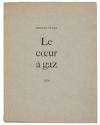Le ceour à gaz [drama]
Artist: Max Ernst (French, 1891-1976)
Publisher: G.L.M. (Paris, 1946 (Guy Lévis Mano))
Printer: Guy Lévis Mano (Paris)
Author: Tristan Tzara (French (born Romania), 1896-1963)
Date: 1946
Dimensions:
Book: H: 10 1/16 in. (255 mm); W: 7 5/8 in. (193 mm); Depth: 1/4 in. (6 mm).
Page (untrimmed): H: 9 3/4 in. (248 mm); W: 7 3/8 in. (187 mm).
Plate size of color etching and drypoint: H: 6 5/8 in. (16.8 cm); W: 5 1/2 in. (14 cm).
Medium: Original print: drypoint with etching and aquatint in mustard and green on van Gelder white wove paper.
Text: letterpress on Van Gelder cream wove paper.
Classification: Books
Credit Line: Gift of Molly and Walter Bareiss
Object number: 1984.453
Label Text:Publisher: Guy Lévis Mano
Man Ray, Facile (Easy). Text by Paul Éluard (1935)
Max Ernst, Le Cœur à gaz (The Gas Heart). Text by Tristan Tzara (1946)
Alberto Giacometti, L’Épervier (Sparrowhawk). Text by Jacques Dupin (1960)
Publisher Guy Lévis Mano produced books from 1923 to 1974 under the name G.L.M. He turned to publication of the surrealist poets in the 1930s. G.L.M. offered a limited number of each book with an original print or photograph. These sold well and subsidized trade editions without original artwork.
One of the finest editions to come from G.L.M. was Facile, a collaboration between the American photographer Man Ray and French poet Paul Éluard. The book features images of Man Ray’s model, Nusch, whom Éluard married in 1934. Éluard’s poems are love poems and Man Ray captures both a charm and sensuality in Nusch’s poses, and in the integration of text and image.
Tristan Tzara’s play Le Cœur à gaz was first performed in 1921. When G.L.M. decided to publish this important text in the 1940s, German-born artist Max Ernst was asked to create an etching to be included in the first 25 copies.
Author and art historian Jacques Dupin had long and close friendships with many artists. As a young writer, Dupin found a patron in Lévis Mano and G.L.M. For L’Épervier, published in 1960, Dupin’s good friend Alberto Giacometti offered an etching to accompany a few limited edition copies of the book.
Man Ray, Facile (Easy). Text by Paul Éluard (1935)
Max Ernst, Le Cœur à gaz (The Gas Heart). Text by Tristan Tzara (1946)
Alberto Giacometti, L’Épervier (Sparrowhawk). Text by Jacques Dupin (1960)
Publisher Guy Lévis Mano produced books from 1923 to 1974 under the name G.L.M. He turned to publication of the surrealist poets in the 1930s. G.L.M. offered a limited number of each book with an original print or photograph. These sold well and subsidized trade editions without original artwork.
One of the finest editions to come from G.L.M. was Facile, a collaboration between the American photographer Man Ray and French poet Paul Éluard. The book features images of Man Ray’s model, Nusch, whom Éluard married in 1934. Éluard’s poems are love poems and Man Ray captures both a charm and sensuality in Nusch’s poses, and in the integration of text and image.
Tristan Tzara’s play Le Cœur à gaz was first performed in 1921. When G.L.M. decided to publish this important text in the 1940s, German-born artist Max Ernst was asked to create an etching to be included in the first 25 copies.
Author and art historian Jacques Dupin had long and close friendships with many artists. As a young writer, Dupin found a patron in Lévis Mano and G.L.M. For L’Épervier, published in 1960, Dupin’s good friend Alberto Giacometti offered an etching to accompany a few limited edition copies of the book.
DescriptionTitle page and frontispiece illustration.
Not on view
In Collection(s)








